University Nursing and Management: Healthcare Deficiencies Report
VerifiedAdded on 2020/03/23
|23
|6289
|49
Report
AI Summary
This report examines major healthcare deficiencies in the Australian healthcare system, specifically within the Victorian context, as highlighted by the review conducted by Dr. Stephen Duckett. The report identifies critical issues such as a lack of clinical leadership, inadequate incident reporting, over-dependence on accreditation, deficiencies in expert committees, and insufficient data reporting. It connects these deficiencies to the National Safety and Quality Health Service Standards (NSQHSS), particularly Standard 1, which focuses on governance for safety and quality. The report emphasizes the need for improved leadership, robust incident management systems, proper accreditation processes, effective expert committees, and comprehensive data collection and dissemination to enhance patient safety and the overall quality of healthcare services. The report highlights the importance of addressing these issues to align with international best practices and improve patient outcomes within the healthcare system.
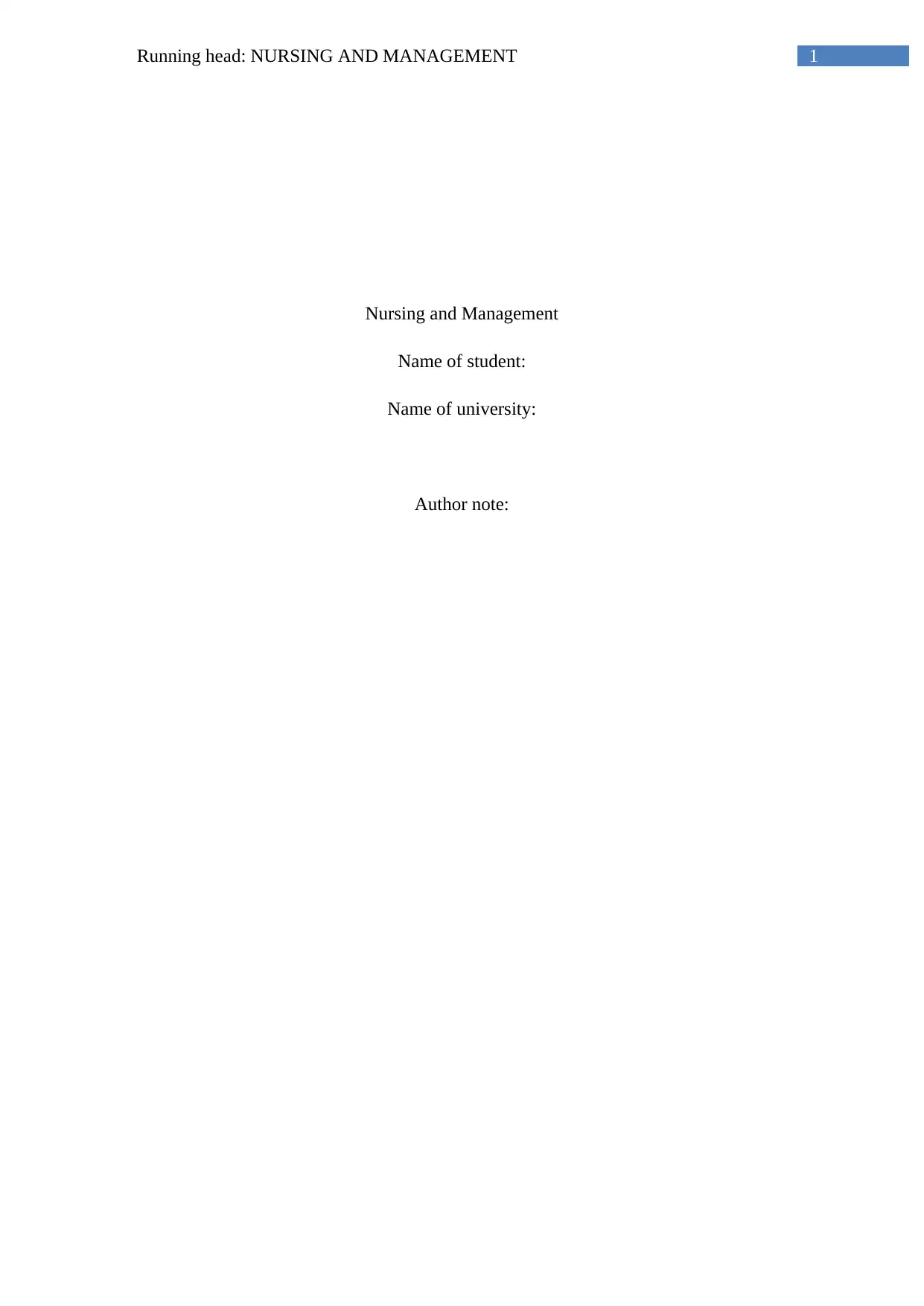
1Running head: NURSING AND MANAGEMENT
Nursing and Management
Name of student:
Name of university:
Author note:
Nursing and Management
Name of student:
Name of university:
Author note:
Paraphrase This Document
Need a fresh take? Get an instant paraphrase of this document with our AI Paraphraser
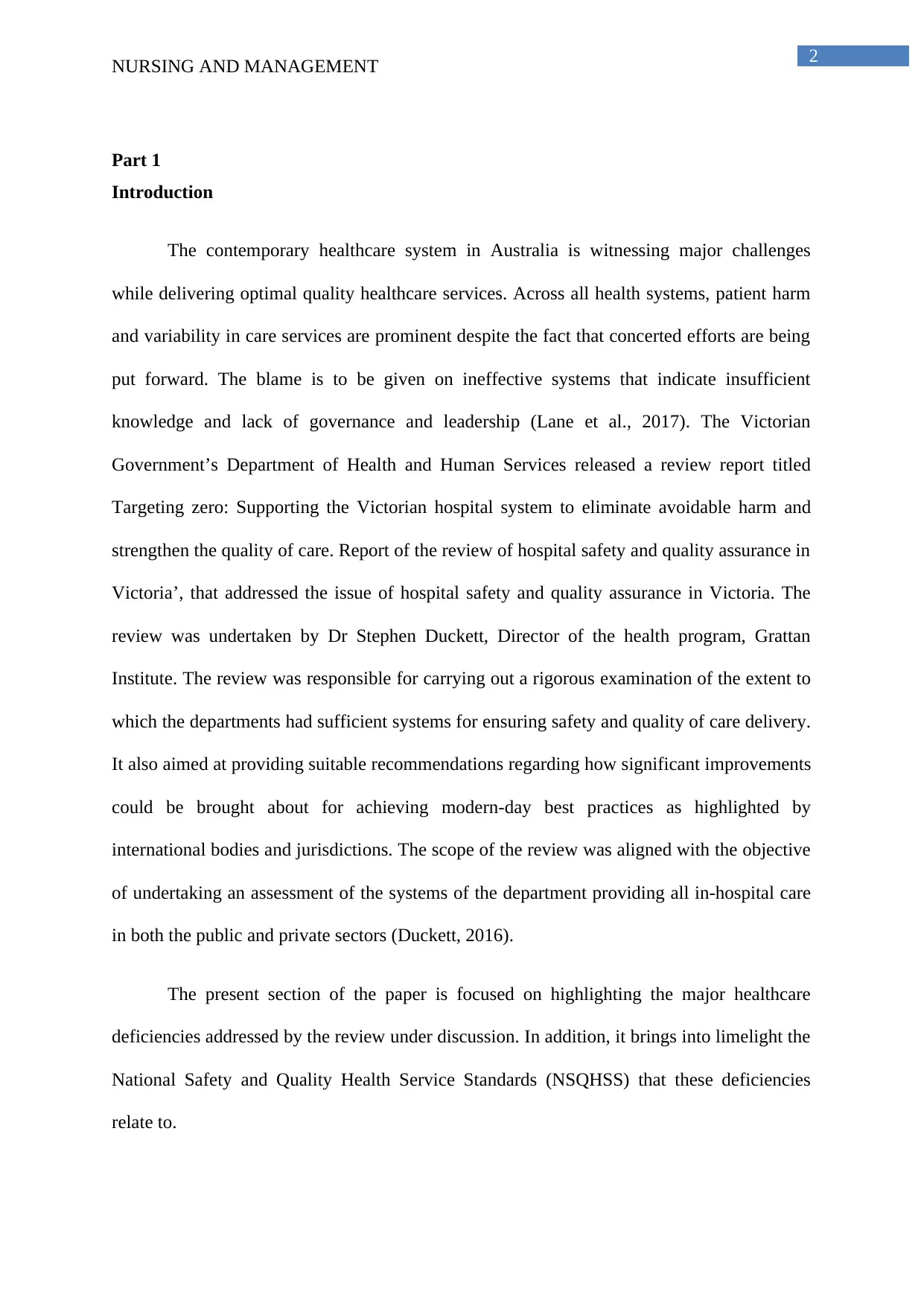
2
NURSING AND MANAGEMENT
Part 1
Introduction
The contemporary healthcare system in Australia is witnessing major challenges
while delivering optimal quality healthcare services. Across all health systems, patient harm
and variability in care services are prominent despite the fact that concerted efforts are being
put forward. The blame is to be given on ineffective systems that indicate insufficient
knowledge and lack of governance and leadership (Lane et al., 2017). The Victorian
Government’s Department of Health and Human Services released a review report titled
Targeting zero: Supporting the Victorian hospital system to eliminate avoidable harm and
strengthen the quality of care. Report of the review of hospital safety and quality assurance in
Victoria’, that addressed the issue of hospital safety and quality assurance in Victoria. The
review was undertaken by Dr Stephen Duckett, Director of the health program, Grattan
Institute. The review was responsible for carrying out a rigorous examination of the extent to
which the departments had sufficient systems for ensuring safety and quality of care delivery.
It also aimed at providing suitable recommendations regarding how significant improvements
could be brought about for achieving modern-day best practices as highlighted by
international bodies and jurisdictions. The scope of the review was aligned with the objective
of undertaking an assessment of the systems of the department providing all in-hospital care
in both the public and private sectors (Duckett, 2016).
The present section of the paper is focused on highlighting the major healthcare
deficiencies addressed by the review under discussion. In addition, it brings into limelight the
National Safety and Quality Health Service Standards (NSQHSS) that these deficiencies
relate to.
NURSING AND MANAGEMENT
Part 1
Introduction
The contemporary healthcare system in Australia is witnessing major challenges
while delivering optimal quality healthcare services. Across all health systems, patient harm
and variability in care services are prominent despite the fact that concerted efforts are being
put forward. The blame is to be given on ineffective systems that indicate insufficient
knowledge and lack of governance and leadership (Lane et al., 2017). The Victorian
Government’s Department of Health and Human Services released a review report titled
Targeting zero: Supporting the Victorian hospital system to eliminate avoidable harm and
strengthen the quality of care. Report of the review of hospital safety and quality assurance in
Victoria’, that addressed the issue of hospital safety and quality assurance in Victoria. The
review was undertaken by Dr Stephen Duckett, Director of the health program, Grattan
Institute. The review was responsible for carrying out a rigorous examination of the extent to
which the departments had sufficient systems for ensuring safety and quality of care delivery.
It also aimed at providing suitable recommendations regarding how significant improvements
could be brought about for achieving modern-day best practices as highlighted by
international bodies and jurisdictions. The scope of the review was aligned with the objective
of undertaking an assessment of the systems of the department providing all in-hospital care
in both the public and private sectors (Duckett, 2016).
The present section of the paper is focused on highlighting the major healthcare
deficiencies addressed by the review under discussion. In addition, it brings into limelight the
National Safety and Quality Health Service Standards (NSQHSS) that these deficiencies
relate to.
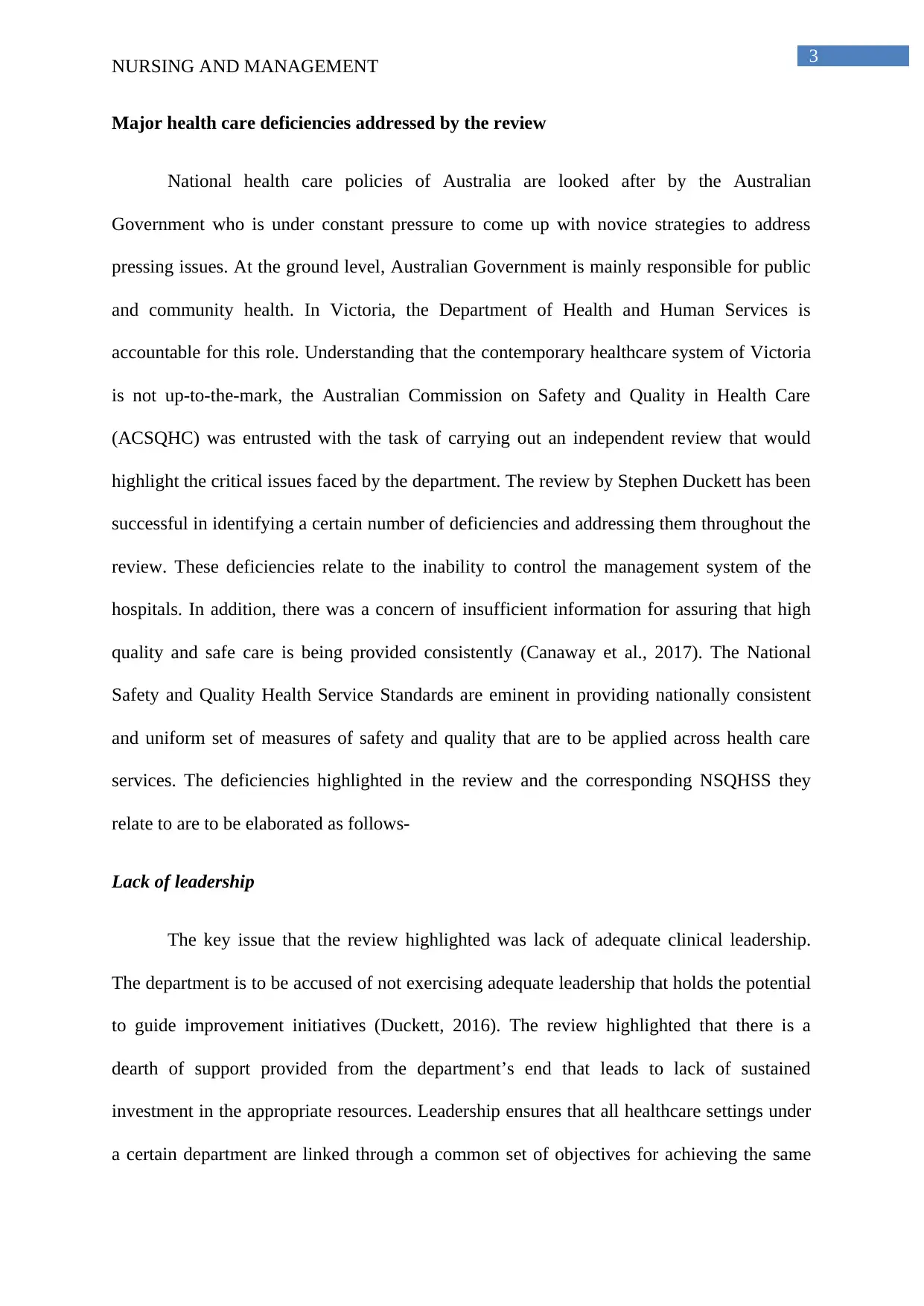
3
NURSING AND MANAGEMENT
Major health care deficiencies addressed by the review
National health care policies of Australia are looked after by the Australian
Government who is under constant pressure to come up with novice strategies to address
pressing issues. At the ground level, Australian Government is mainly responsible for public
and community health. In Victoria, the Department of Health and Human Services is
accountable for this role. Understanding that the contemporary healthcare system of Victoria
is not up-to-the-mark, the Australian Commission on Safety and Quality in Health Care
(ACSQHC) was entrusted with the task of carrying out an independent review that would
highlight the critical issues faced by the department. The review by Stephen Duckett has been
successful in identifying a certain number of deficiencies and addressing them throughout the
review. These deficiencies relate to the inability to control the management system of the
hospitals. In addition, there was a concern of insufficient information for assuring that high
quality and safe care is being provided consistently (Canaway et al., 2017). The National
Safety and Quality Health Service Standards are eminent in providing nationally consistent
and uniform set of measures of safety and quality that are to be applied across health care
services. The deficiencies highlighted in the review and the corresponding NSQHSS they
relate to are to be elaborated as follows-
Lack of leadership
The key issue that the review highlighted was lack of adequate clinical leadership.
The department is to be accused of not exercising adequate leadership that holds the potential
to guide improvement initiatives (Duckett, 2016). The review highlighted that there is a
dearth of support provided from the department’s end that leads to lack of sustained
investment in the appropriate resources. Leadership ensures that all healthcare settings under
a certain department are linked through a common set of objectives for achieving the same
NURSING AND MANAGEMENT
Major health care deficiencies addressed by the review
National health care policies of Australia are looked after by the Australian
Government who is under constant pressure to come up with novice strategies to address
pressing issues. At the ground level, Australian Government is mainly responsible for public
and community health. In Victoria, the Department of Health and Human Services is
accountable for this role. Understanding that the contemporary healthcare system of Victoria
is not up-to-the-mark, the Australian Commission on Safety and Quality in Health Care
(ACSQHC) was entrusted with the task of carrying out an independent review that would
highlight the critical issues faced by the department. The review by Stephen Duckett has been
successful in identifying a certain number of deficiencies and addressing them throughout the
review. These deficiencies relate to the inability to control the management system of the
hospitals. In addition, there was a concern of insufficient information for assuring that high
quality and safe care is being provided consistently (Canaway et al., 2017). The National
Safety and Quality Health Service Standards are eminent in providing nationally consistent
and uniform set of measures of safety and quality that are to be applied across health care
services. The deficiencies highlighted in the review and the corresponding NSQHSS they
relate to are to be elaborated as follows-
Lack of leadership
The key issue that the review highlighted was lack of adequate clinical leadership.
The department is to be accused of not exercising adequate leadership that holds the potential
to guide improvement initiatives (Duckett, 2016). The review highlighted that there is a
dearth of support provided from the department’s end that leads to lack of sustained
investment in the appropriate resources. Leadership ensures that all healthcare settings under
a certain department are linked through a common set of objectives for achieving the same
⊘ This is a preview!⊘
Do you want full access?
Subscribe today to unlock all pages.

Trusted by 1+ million students worldwide
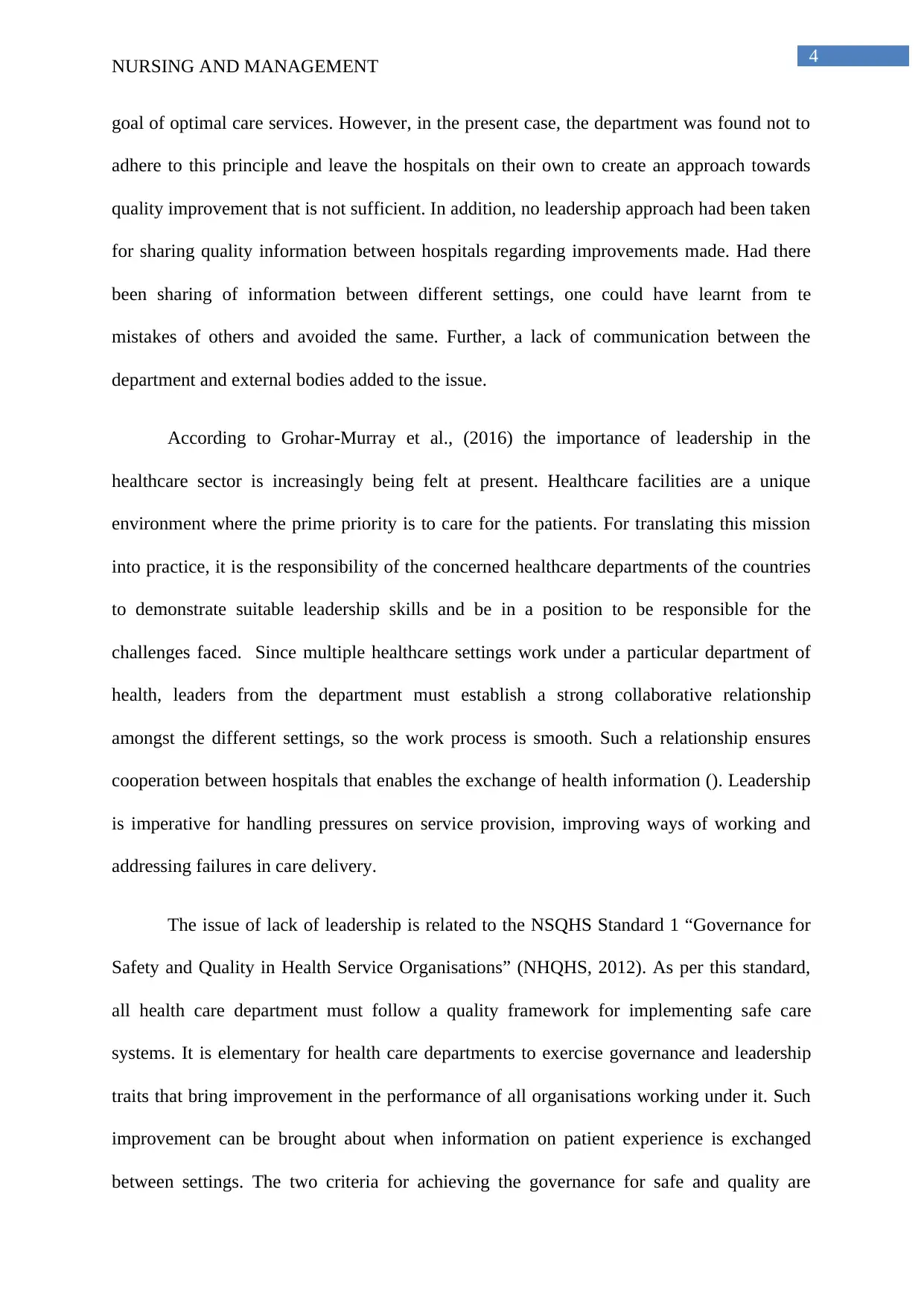
4
NURSING AND MANAGEMENT
goal of optimal care services. However, in the present case, the department was found not to
adhere to this principle and leave the hospitals on their own to create an approach towards
quality improvement that is not sufficient. In addition, no leadership approach had been taken
for sharing quality information between hospitals regarding improvements made. Had there
been sharing of information between different settings, one could have learnt from te
mistakes of others and avoided the same. Further, a lack of communication between the
department and external bodies added to the issue.
According to Grohar-Murray et al., (2016) the importance of leadership in the
healthcare sector is increasingly being felt at present. Healthcare facilities are a unique
environment where the prime priority is to care for the patients. For translating this mission
into practice, it is the responsibility of the concerned healthcare departments of the countries
to demonstrate suitable leadership skills and be in a position to be responsible for the
challenges faced. Since multiple healthcare settings work under a particular department of
health, leaders from the department must establish a strong collaborative relationship
amongst the different settings, so the work process is smooth. Such a relationship ensures
cooperation between hospitals that enables the exchange of health information (). Leadership
is imperative for handling pressures on service provision, improving ways of working and
addressing failures in care delivery.
The issue of lack of leadership is related to the NSQHS Standard 1 “Governance for
Safety and Quality in Health Service Organisations” (NHQHS, 2012). As per this standard,
all health care department must follow a quality framework for implementing safe care
systems. It is elementary for health care departments to exercise governance and leadership
traits that bring improvement in the performance of all organisations working under it. Such
improvement can be brought about when information on patient experience is exchanged
between settings. The two criteria for achieving the governance for safe and quality are
NURSING AND MANAGEMENT
goal of optimal care services. However, in the present case, the department was found not to
adhere to this principle and leave the hospitals on their own to create an approach towards
quality improvement that is not sufficient. In addition, no leadership approach had been taken
for sharing quality information between hospitals regarding improvements made. Had there
been sharing of information between different settings, one could have learnt from te
mistakes of others and avoided the same. Further, a lack of communication between the
department and external bodies added to the issue.
According to Grohar-Murray et al., (2016) the importance of leadership in the
healthcare sector is increasingly being felt at present. Healthcare facilities are a unique
environment where the prime priority is to care for the patients. For translating this mission
into practice, it is the responsibility of the concerned healthcare departments of the countries
to demonstrate suitable leadership skills and be in a position to be responsible for the
challenges faced. Since multiple healthcare settings work under a particular department of
health, leaders from the department must establish a strong collaborative relationship
amongst the different settings, so the work process is smooth. Such a relationship ensures
cooperation between hospitals that enables the exchange of health information (). Leadership
is imperative for handling pressures on service provision, improving ways of working and
addressing failures in care delivery.
The issue of lack of leadership is related to the NSQHS Standard 1 “Governance for
Safety and Quality in Health Service Organisations” (NHQHS, 2012). As per this standard,
all health care department must follow a quality framework for implementing safe care
systems. It is elementary for health care departments to exercise governance and leadership
traits that bring improvement in the performance of all organisations working under it. Such
improvement can be brought about when information on patient experience is exchanged
between settings. The two criteria for achieving the governance for safe and quality are
Paraphrase This Document
Need a fresh take? Get an instant paraphrase of this document with our AI Paraphraser
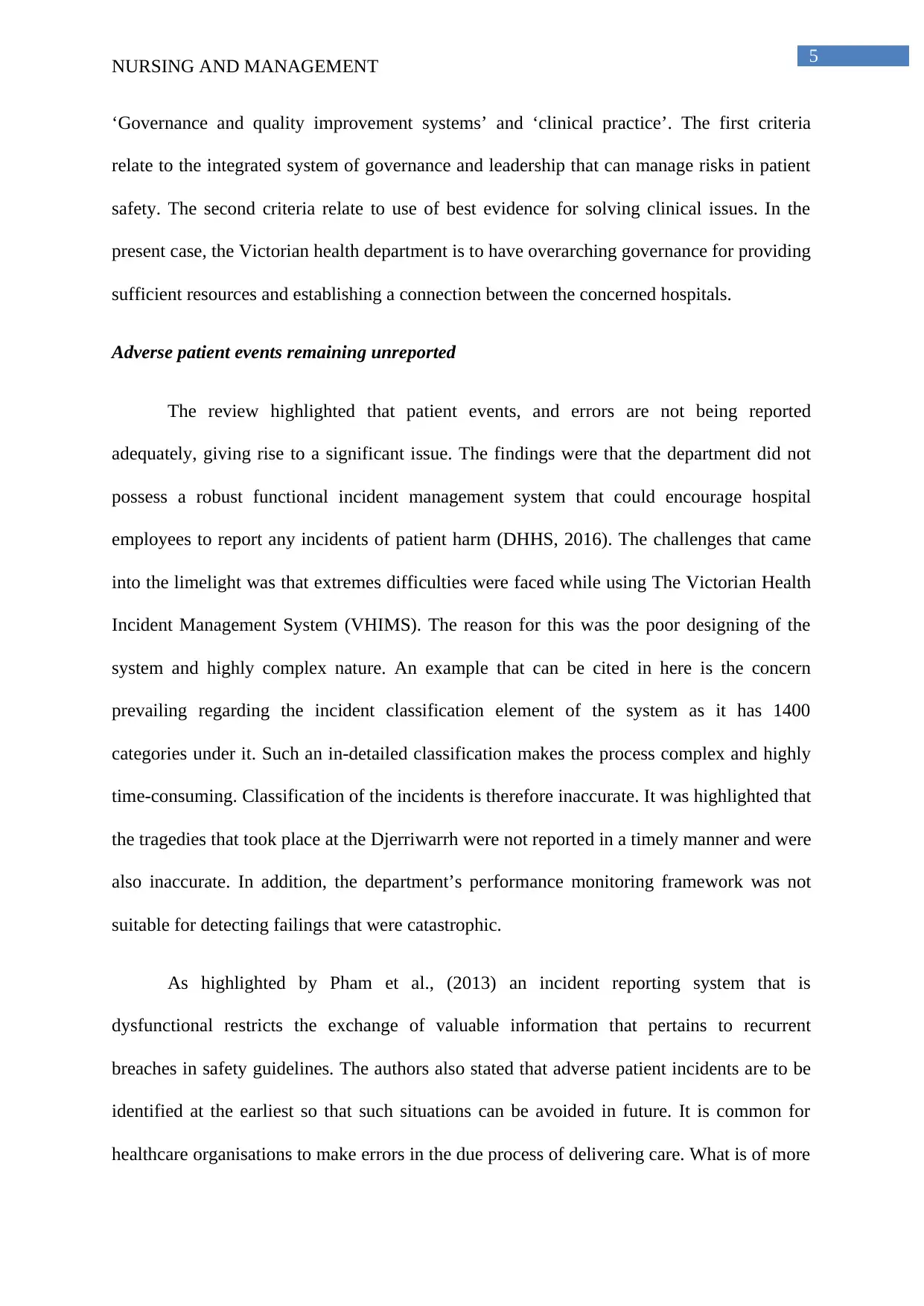
5
NURSING AND MANAGEMENT
‘Governance and quality improvement systems’ and ‘clinical practice’. The first criteria
relate to the integrated system of governance and leadership that can manage risks in patient
safety. The second criteria relate to use of best evidence for solving clinical issues. In the
present case, the Victorian health department is to have overarching governance for providing
sufficient resources and establishing a connection between the concerned hospitals.
Adverse patient events remaining unreported
The review highlighted that patient events, and errors are not being reported
adequately, giving rise to a significant issue. The findings were that the department did not
possess a robust functional incident management system that could encourage hospital
employees to report any incidents of patient harm (DHHS, 2016). The challenges that came
into the limelight was that extremes difficulties were faced while using The Victorian Health
Incident Management System (VHIMS). The reason for this was the poor designing of the
system and highly complex nature. An example that can be cited in here is the concern
prevailing regarding the incident classification element of the system as it has 1400
categories under it. Such an in-detailed classification makes the process complex and highly
time-consuming. Classification of the incidents is therefore inaccurate. It was highlighted that
the tragedies that took place at the Djerriwarrh were not reported in a timely manner and were
also inaccurate. In addition, the department’s performance monitoring framework was not
suitable for detecting failings that were catastrophic.
As highlighted by Pham et al., (2013) an incident reporting system that is
dysfunctional restricts the exchange of valuable information that pertains to recurrent
breaches in safety guidelines. The authors also stated that adverse patient incidents are to be
identified at the earliest so that such situations can be avoided in future. It is common for
healthcare organisations to make errors in the due process of delivering care. What is of more
NURSING AND MANAGEMENT
‘Governance and quality improvement systems’ and ‘clinical practice’. The first criteria
relate to the integrated system of governance and leadership that can manage risks in patient
safety. The second criteria relate to use of best evidence for solving clinical issues. In the
present case, the Victorian health department is to have overarching governance for providing
sufficient resources and establishing a connection between the concerned hospitals.
Adverse patient events remaining unreported
The review highlighted that patient events, and errors are not being reported
adequately, giving rise to a significant issue. The findings were that the department did not
possess a robust functional incident management system that could encourage hospital
employees to report any incidents of patient harm (DHHS, 2016). The challenges that came
into the limelight was that extremes difficulties were faced while using The Victorian Health
Incident Management System (VHIMS). The reason for this was the poor designing of the
system and highly complex nature. An example that can be cited in here is the concern
prevailing regarding the incident classification element of the system as it has 1400
categories under it. Such an in-detailed classification makes the process complex and highly
time-consuming. Classification of the incidents is therefore inaccurate. It was highlighted that
the tragedies that took place at the Djerriwarrh were not reported in a timely manner and were
also inaccurate. In addition, the department’s performance monitoring framework was not
suitable for detecting failings that were catastrophic.
As highlighted by Pham et al., (2013) an incident reporting system that is
dysfunctional restricts the exchange of valuable information that pertains to recurrent
breaches in safety guidelines. The authors also stated that adverse patient incidents are to be
identified at the earliest so that such situations can be avoided in future. It is common for
healthcare organisations to make errors in the due process of delivering care. What is of more
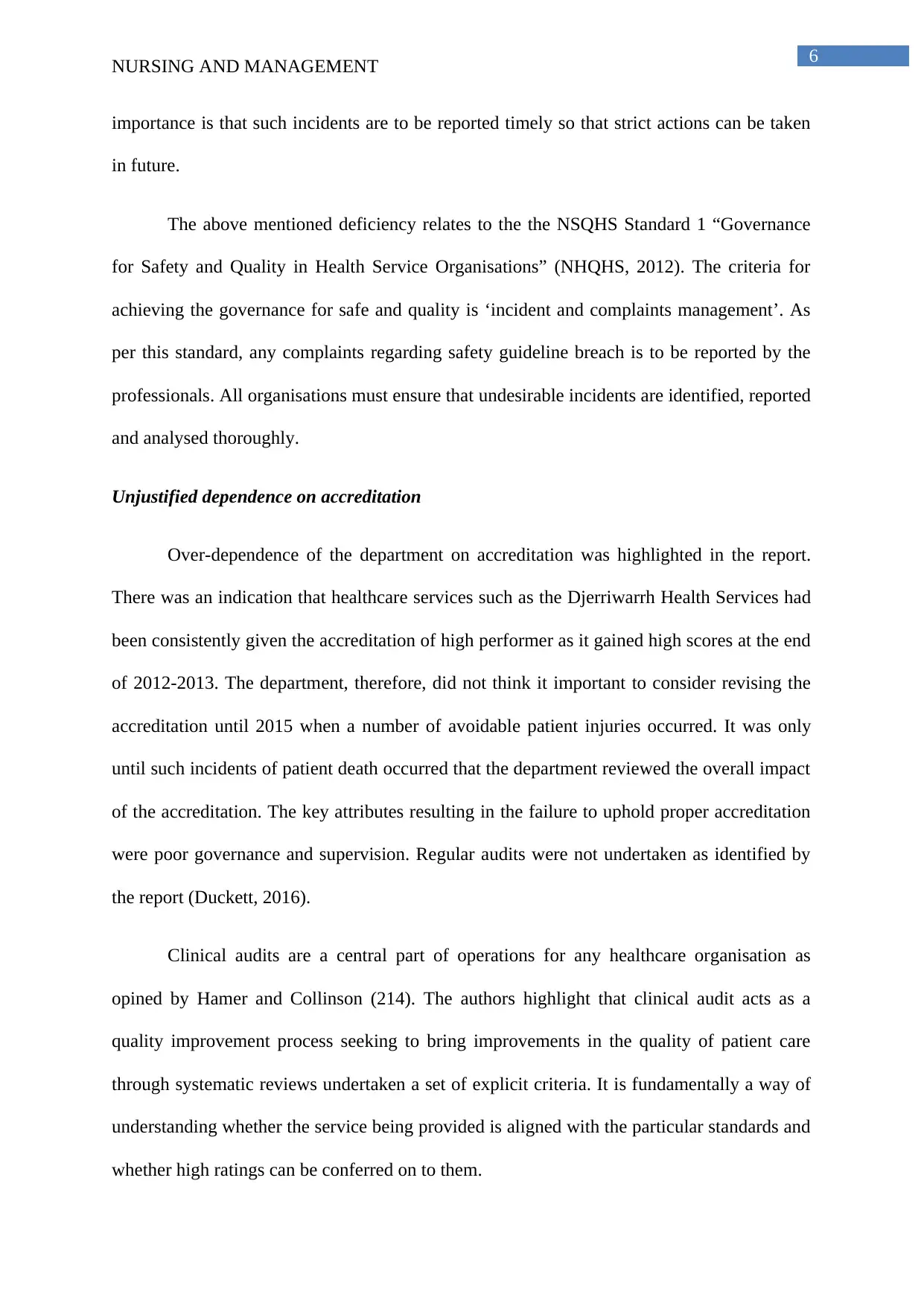
6
NURSING AND MANAGEMENT
importance is that such incidents are to be reported timely so that strict actions can be taken
in future.
The above mentioned deficiency relates to the the NSQHS Standard 1 “Governance
for Safety and Quality in Health Service Organisations” (NHQHS, 2012). The criteria for
achieving the governance for safe and quality is ‘incident and complaints management’. As
per this standard, any complaints regarding safety guideline breach is to be reported by the
professionals. All organisations must ensure that undesirable incidents are identified, reported
and analysed thoroughly.
Unjustified dependence on accreditation
Over-dependence of the department on accreditation was highlighted in the report.
There was an indication that healthcare services such as the Djerriwarrh Health Services had
been consistently given the accreditation of high performer as it gained high scores at the end
of 2012-2013. The department, therefore, did not think it important to consider revising the
accreditation until 2015 when a number of avoidable patient injuries occurred. It was only
until such incidents of patient death occurred that the department reviewed the overall impact
of the accreditation. The key attributes resulting in the failure to uphold proper accreditation
were poor governance and supervision. Regular audits were not undertaken as identified by
the report (Duckett, 2016).
Clinical audits are a central part of operations for any healthcare organisation as
opined by Hamer and Collinson (214). The authors highlight that clinical audit acts as a
quality improvement process seeking to bring improvements in the quality of patient care
through systematic reviews undertaken a set of explicit criteria. It is fundamentally a way of
understanding whether the service being provided is aligned with the particular standards and
whether high ratings can be conferred on to them.
NURSING AND MANAGEMENT
importance is that such incidents are to be reported timely so that strict actions can be taken
in future.
The above mentioned deficiency relates to the the NSQHS Standard 1 “Governance
for Safety and Quality in Health Service Organisations” (NHQHS, 2012). The criteria for
achieving the governance for safe and quality is ‘incident and complaints management’. As
per this standard, any complaints regarding safety guideline breach is to be reported by the
professionals. All organisations must ensure that undesirable incidents are identified, reported
and analysed thoroughly.
Unjustified dependence on accreditation
Over-dependence of the department on accreditation was highlighted in the report.
There was an indication that healthcare services such as the Djerriwarrh Health Services had
been consistently given the accreditation of high performer as it gained high scores at the end
of 2012-2013. The department, therefore, did not think it important to consider revising the
accreditation until 2015 when a number of avoidable patient injuries occurred. It was only
until such incidents of patient death occurred that the department reviewed the overall impact
of the accreditation. The key attributes resulting in the failure to uphold proper accreditation
were poor governance and supervision. Regular audits were not undertaken as identified by
the report (Duckett, 2016).
Clinical audits are a central part of operations for any healthcare organisation as
opined by Hamer and Collinson (214). The authors highlight that clinical audit acts as a
quality improvement process seeking to bring improvements in the quality of patient care
through systematic reviews undertaken a set of explicit criteria. It is fundamentally a way of
understanding whether the service being provided is aligned with the particular standards and
whether high ratings can be conferred on to them.
⊘ This is a preview!⊘
Do you want full access?
Subscribe today to unlock all pages.

Trusted by 1+ million students worldwide
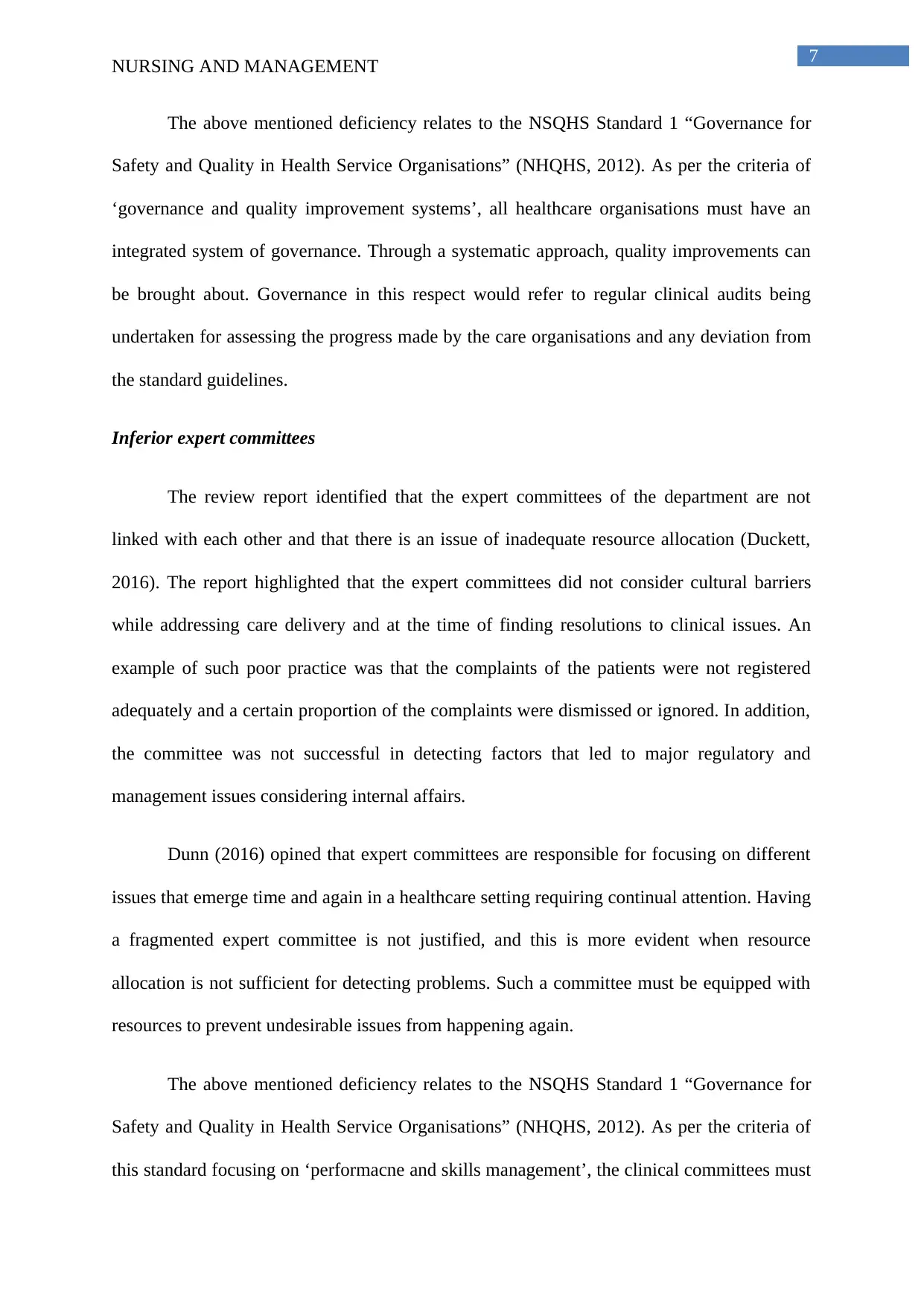
7
NURSING AND MANAGEMENT
The above mentioned deficiency relates to the NSQHS Standard 1 “Governance for
Safety and Quality in Health Service Organisations” (NHQHS, 2012). As per the criteria of
‘governance and quality improvement systems’, all healthcare organisations must have an
integrated system of governance. Through a systematic approach, quality improvements can
be brought about. Governance in this respect would refer to regular clinical audits being
undertaken for assessing the progress made by the care organisations and any deviation from
the standard guidelines.
Inferior expert committees
The review report identified that the expert committees of the department are not
linked with each other and that there is an issue of inadequate resource allocation (Duckett,
2016). The report highlighted that the expert committees did not consider cultural barriers
while addressing care delivery and at the time of finding resolutions to clinical issues. An
example of such poor practice was that the complaints of the patients were not registered
adequately and a certain proportion of the complaints were dismissed or ignored. In addition,
the committee was not successful in detecting factors that led to major regulatory and
management issues considering internal affairs.
Dunn (2016) opined that expert committees are responsible for focusing on different
issues that emerge time and again in a healthcare setting requiring continual attention. Having
a fragmented expert committee is not justified, and this is more evident when resource
allocation is not sufficient for detecting problems. Such a committee must be equipped with
resources to prevent undesirable issues from happening again.
The above mentioned deficiency relates to the NSQHS Standard 1 “Governance for
Safety and Quality in Health Service Organisations” (NHQHS, 2012). As per the criteria of
this standard focusing on ‘performacne and skills management’, the clinical committees must
NURSING AND MANAGEMENT
The above mentioned deficiency relates to the NSQHS Standard 1 “Governance for
Safety and Quality in Health Service Organisations” (NHQHS, 2012). As per the criteria of
‘governance and quality improvement systems’, all healthcare organisations must have an
integrated system of governance. Through a systematic approach, quality improvements can
be brought about. Governance in this respect would refer to regular clinical audits being
undertaken for assessing the progress made by the care organisations and any deviation from
the standard guidelines.
Inferior expert committees
The review report identified that the expert committees of the department are not
linked with each other and that there is an issue of inadequate resource allocation (Duckett,
2016). The report highlighted that the expert committees did not consider cultural barriers
while addressing care delivery and at the time of finding resolutions to clinical issues. An
example of such poor practice was that the complaints of the patients were not registered
adequately and a certain proportion of the complaints were dismissed or ignored. In addition,
the committee was not successful in detecting factors that led to major regulatory and
management issues considering internal affairs.
Dunn (2016) opined that expert committees are responsible for focusing on different
issues that emerge time and again in a healthcare setting requiring continual attention. Having
a fragmented expert committee is not justified, and this is more evident when resource
allocation is not sufficient for detecting problems. Such a committee must be equipped with
resources to prevent undesirable issues from happening again.
The above mentioned deficiency relates to the NSQHS Standard 1 “Governance for
Safety and Quality in Health Service Organisations” (NHQHS, 2012). As per the criteria of
this standard focusing on ‘performacne and skills management’, the clinical committees must
Paraphrase This Document
Need a fresh take? Get an instant paraphrase of this document with our AI Paraphraser
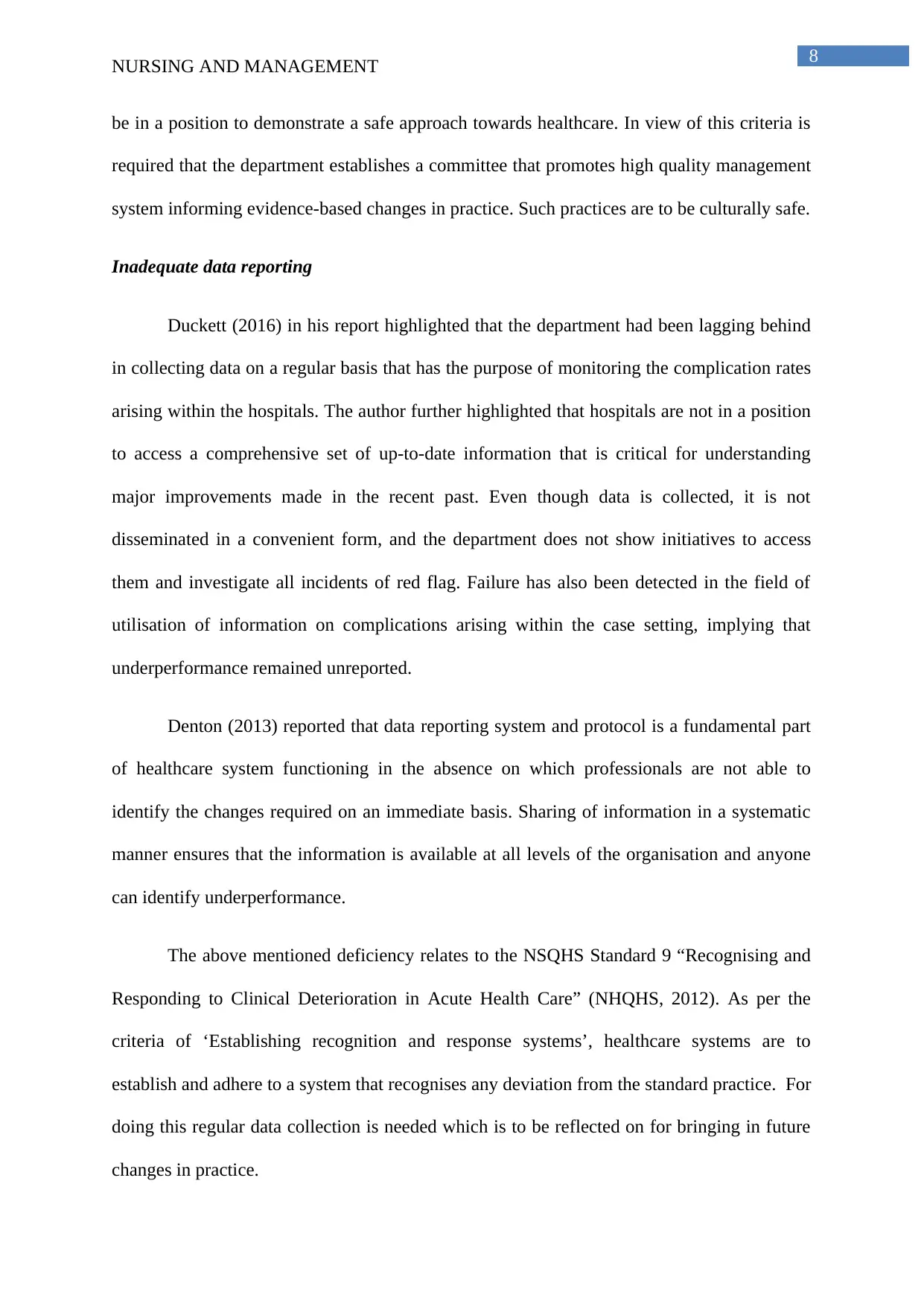
8
NURSING AND MANAGEMENT
be in a position to demonstrate a safe approach towards healthcare. In view of this criteria is
required that the department establishes a committee that promotes high quality management
system informing evidence-based changes in practice. Such practices are to be culturally safe.
Inadequate data reporting
Duckett (2016) in his report highlighted that the department had been lagging behind
in collecting data on a regular basis that has the purpose of monitoring the complication rates
arising within the hospitals. The author further highlighted that hospitals are not in a position
to access a comprehensive set of up-to-date information that is critical for understanding
major improvements made in the recent past. Even though data is collected, it is not
disseminated in a convenient form, and the department does not show initiatives to access
them and investigate all incidents of red flag. Failure has also been detected in the field of
utilisation of information on complications arising within the case setting, implying that
underperformance remained unreported.
Denton (2013) reported that data reporting system and protocol is a fundamental part
of healthcare system functioning in the absence on which professionals are not able to
identify the changes required on an immediate basis. Sharing of information in a systematic
manner ensures that the information is available at all levels of the organisation and anyone
can identify underperformance.
The above mentioned deficiency relates to the NSQHS Standard 9 “Recognising and
Responding to Clinical Deterioration in Acute Health Care” (NHQHS, 2012). As per the
criteria of ‘Establishing recognition and response systems’, healthcare systems are to
establish and adhere to a system that recognises any deviation from the standard practice. For
doing this regular data collection is needed which is to be reflected on for bringing in future
changes in practice.
NURSING AND MANAGEMENT
be in a position to demonstrate a safe approach towards healthcare. In view of this criteria is
required that the department establishes a committee that promotes high quality management
system informing evidence-based changes in practice. Such practices are to be culturally safe.
Inadequate data reporting
Duckett (2016) in his report highlighted that the department had been lagging behind
in collecting data on a regular basis that has the purpose of monitoring the complication rates
arising within the hospitals. The author further highlighted that hospitals are not in a position
to access a comprehensive set of up-to-date information that is critical for understanding
major improvements made in the recent past. Even though data is collected, it is not
disseminated in a convenient form, and the department does not show initiatives to access
them and investigate all incidents of red flag. Failure has also been detected in the field of
utilisation of information on complications arising within the case setting, implying that
underperformance remained unreported.
Denton (2013) reported that data reporting system and protocol is a fundamental part
of healthcare system functioning in the absence on which professionals are not able to
identify the changes required on an immediate basis. Sharing of information in a systematic
manner ensures that the information is available at all levels of the organisation and anyone
can identify underperformance.
The above mentioned deficiency relates to the NSQHS Standard 9 “Recognising and
Responding to Clinical Deterioration in Acute Health Care” (NHQHS, 2012). As per the
criteria of ‘Establishing recognition and response systems’, healthcare systems are to
establish and adhere to a system that recognises any deviation from the standard practice. For
doing this regular data collection is needed which is to be reflected on for bringing in future
changes in practice.
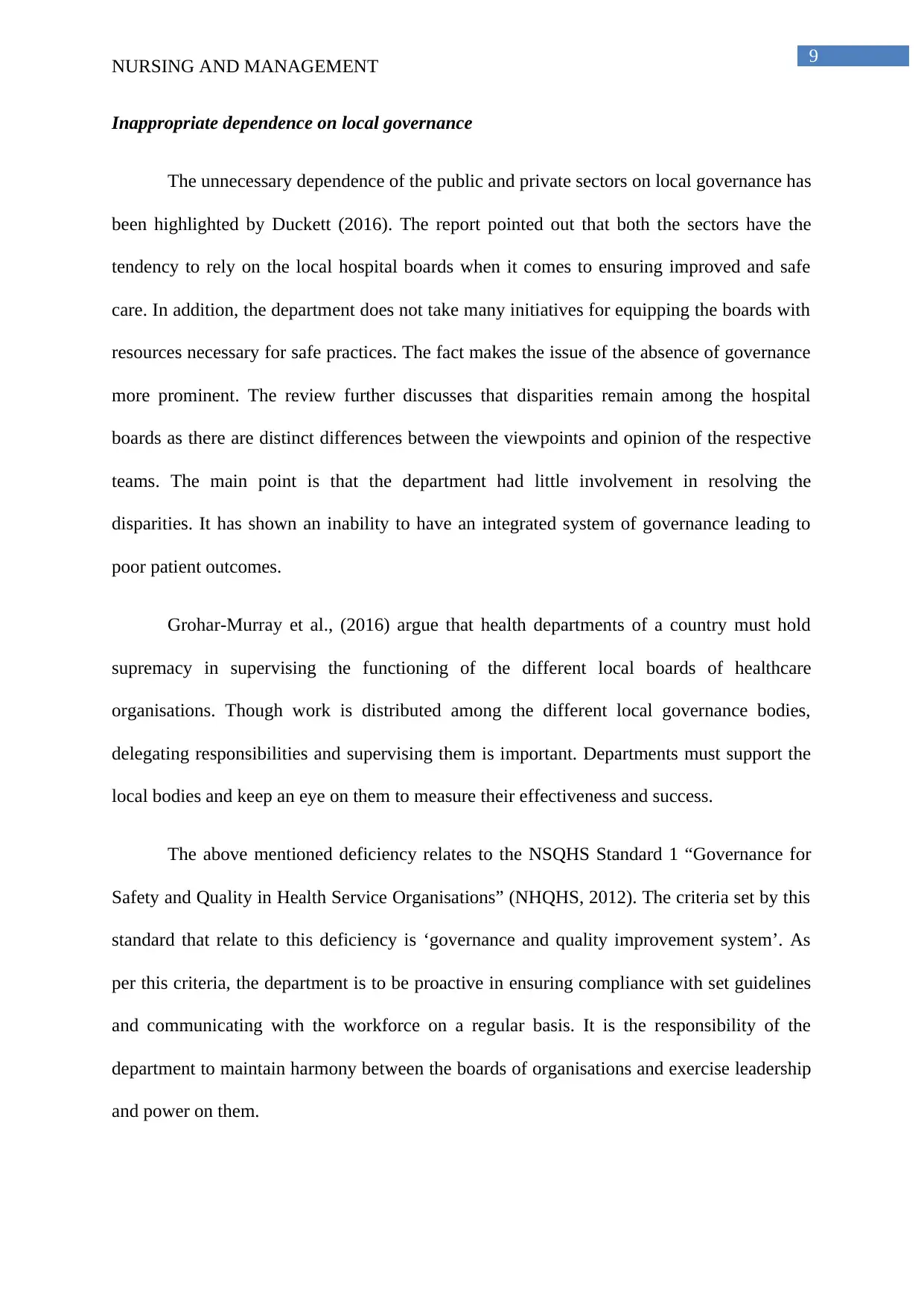
9
NURSING AND MANAGEMENT
Inappropriate dependence on local governance
The unnecessary dependence of the public and private sectors on local governance has
been highlighted by Duckett (2016). The report pointed out that both the sectors have the
tendency to rely on the local hospital boards when it comes to ensuring improved and safe
care. In addition, the department does not take many initiatives for equipping the boards with
resources necessary for safe practices. The fact makes the issue of the absence of governance
more prominent. The review further discusses that disparities remain among the hospital
boards as there are distinct differences between the viewpoints and opinion of the respective
teams. The main point is that the department had little involvement in resolving the
disparities. It has shown an inability to have an integrated system of governance leading to
poor patient outcomes.
Grohar-Murray et al., (2016) argue that health departments of a country must hold
supremacy in supervising the functioning of the different local boards of healthcare
organisations. Though work is distributed among the different local governance bodies,
delegating responsibilities and supervising them is important. Departments must support the
local bodies and keep an eye on them to measure their effectiveness and success.
The above mentioned deficiency relates to the NSQHS Standard 1 “Governance for
Safety and Quality in Health Service Organisations” (NHQHS, 2012). The criteria set by this
standard that relate to this deficiency is ‘governance and quality improvement system’. As
per this criteria, the department is to be proactive in ensuring compliance with set guidelines
and communicating with the workforce on a regular basis. It is the responsibility of the
department to maintain harmony between the boards of organisations and exercise leadership
and power on them.
NURSING AND MANAGEMENT
Inappropriate dependence on local governance
The unnecessary dependence of the public and private sectors on local governance has
been highlighted by Duckett (2016). The report pointed out that both the sectors have the
tendency to rely on the local hospital boards when it comes to ensuring improved and safe
care. In addition, the department does not take many initiatives for equipping the boards with
resources necessary for safe practices. The fact makes the issue of the absence of governance
more prominent. The review further discusses that disparities remain among the hospital
boards as there are distinct differences between the viewpoints and opinion of the respective
teams. The main point is that the department had little involvement in resolving the
disparities. It has shown an inability to have an integrated system of governance leading to
poor patient outcomes.
Grohar-Murray et al., (2016) argue that health departments of a country must hold
supremacy in supervising the functioning of the different local boards of healthcare
organisations. Though work is distributed among the different local governance bodies,
delegating responsibilities and supervising them is important. Departments must support the
local bodies and keep an eye on them to measure their effectiveness and success.
The above mentioned deficiency relates to the NSQHS Standard 1 “Governance for
Safety and Quality in Health Service Organisations” (NHQHS, 2012). The criteria set by this
standard that relate to this deficiency is ‘governance and quality improvement system’. As
per this criteria, the department is to be proactive in ensuring compliance with set guidelines
and communicating with the workforce on a regular basis. It is the responsibility of the
department to maintain harmony between the boards of organisations and exercise leadership
and power on them.
⊘ This is a preview!⊘
Do you want full access?
Subscribe today to unlock all pages.

Trusted by 1+ million students worldwide
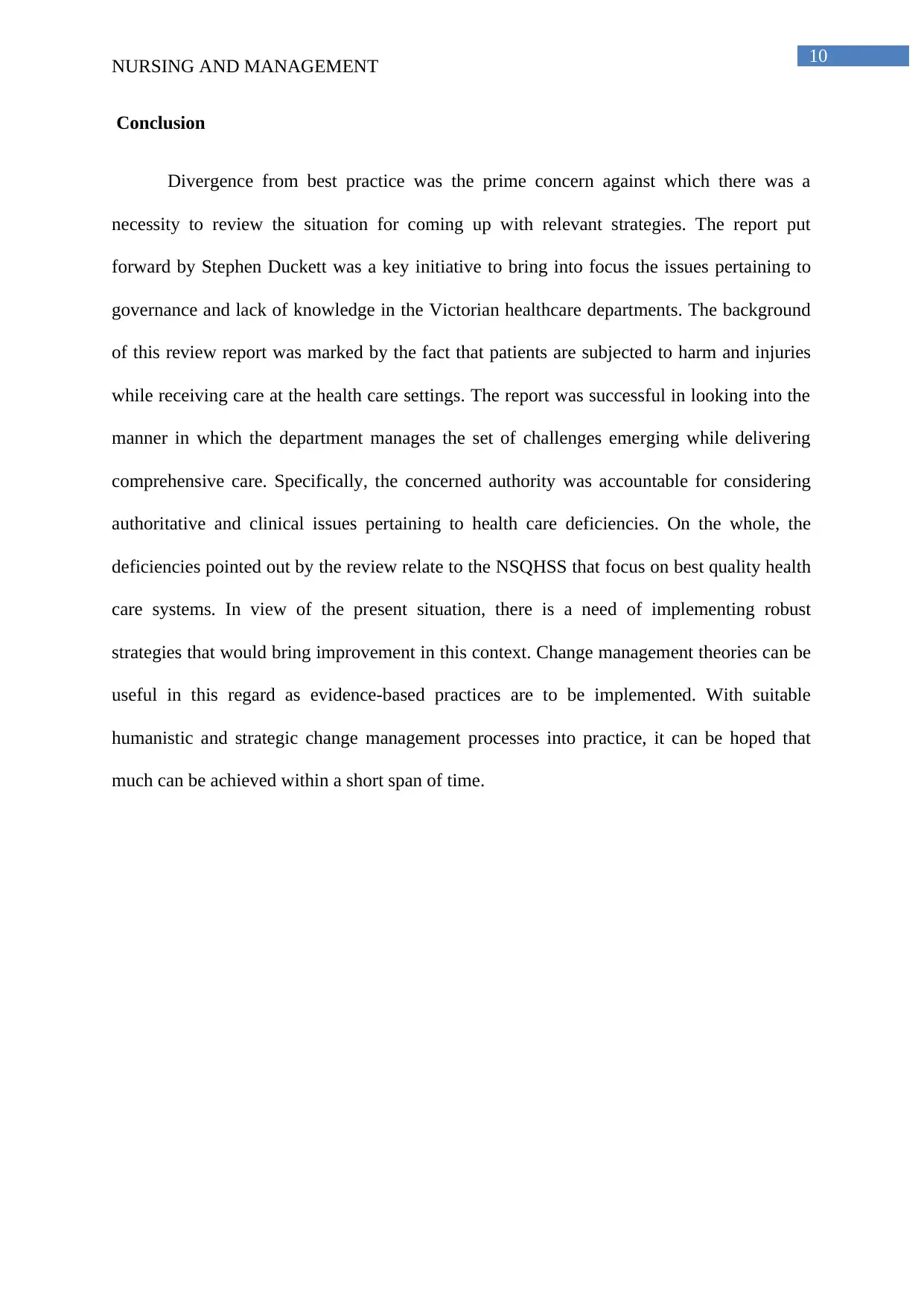
10
NURSING AND MANAGEMENT
Conclusion
Divergence from best practice was the prime concern against which there was a
necessity to review the situation for coming up with relevant strategies. The report put
forward by Stephen Duckett was a key initiative to bring into focus the issues pertaining to
governance and lack of knowledge in the Victorian healthcare departments. The background
of this review report was marked by the fact that patients are subjected to harm and injuries
while receiving care at the health care settings. The report was successful in looking into the
manner in which the department manages the set of challenges emerging while delivering
comprehensive care. Specifically, the concerned authority was accountable for considering
authoritative and clinical issues pertaining to health care deficiencies. On the whole, the
deficiencies pointed out by the review relate to the NSQHSS that focus on best quality health
care systems. In view of the present situation, there is a need of implementing robust
strategies that would bring improvement in this context. Change management theories can be
useful in this regard as evidence-based practices are to be implemented. With suitable
humanistic and strategic change management processes into practice, it can be hoped that
much can be achieved within a short span of time.
NURSING AND MANAGEMENT
Conclusion
Divergence from best practice was the prime concern against which there was a
necessity to review the situation for coming up with relevant strategies. The report put
forward by Stephen Duckett was a key initiative to bring into focus the issues pertaining to
governance and lack of knowledge in the Victorian healthcare departments. The background
of this review report was marked by the fact that patients are subjected to harm and injuries
while receiving care at the health care settings. The report was successful in looking into the
manner in which the department manages the set of challenges emerging while delivering
comprehensive care. Specifically, the concerned authority was accountable for considering
authoritative and clinical issues pertaining to health care deficiencies. On the whole, the
deficiencies pointed out by the review relate to the NSQHSS that focus on best quality health
care systems. In view of the present situation, there is a need of implementing robust
strategies that would bring improvement in this context. Change management theories can be
useful in this regard as evidence-based practices are to be implemented. With suitable
humanistic and strategic change management processes into practice, it can be hoped that
much can be achieved within a short span of time.
Paraphrase This Document
Need a fresh take? Get an instant paraphrase of this document with our AI Paraphraser
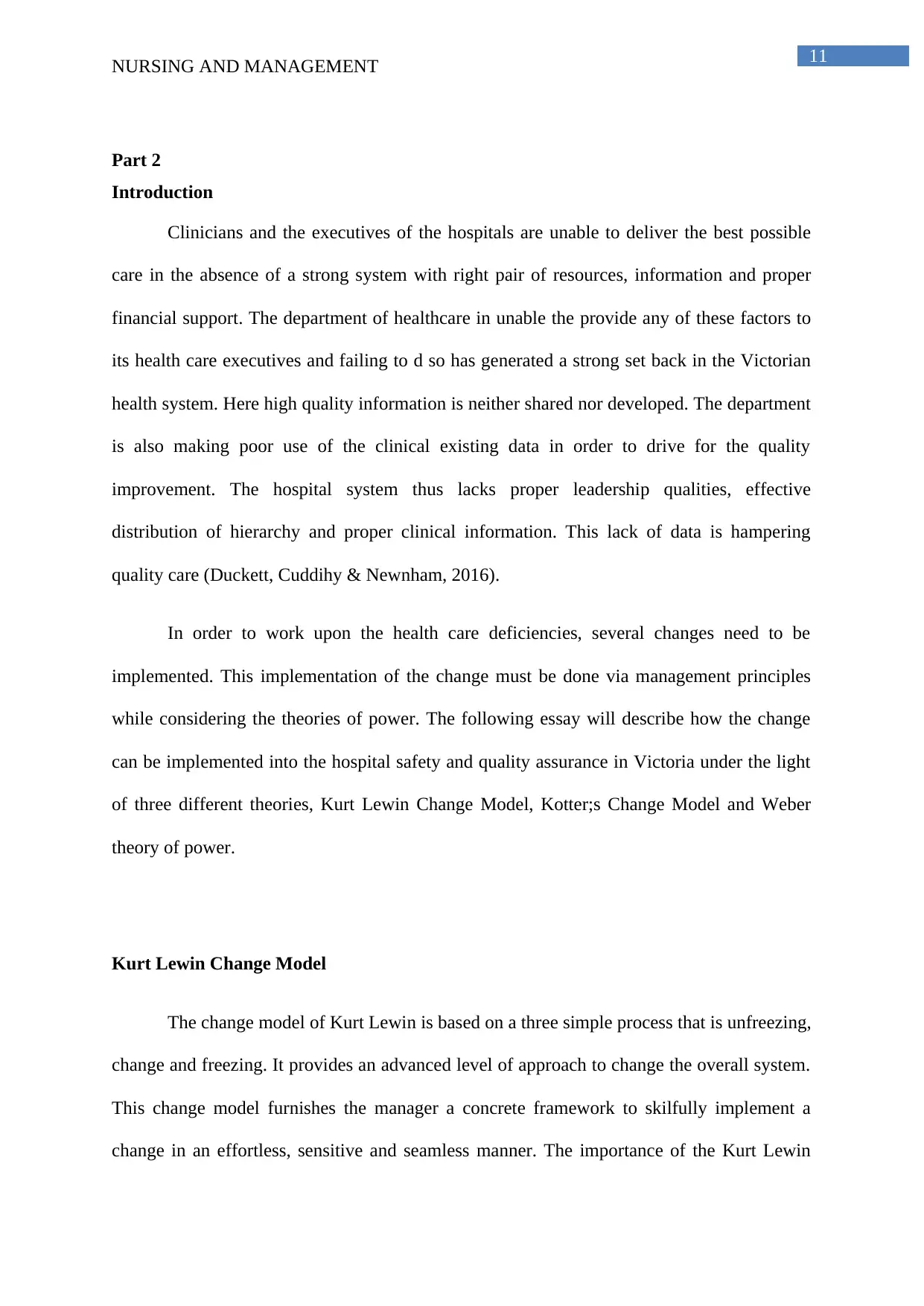
11
NURSING AND MANAGEMENT
Part 2
Introduction
Clinicians and the executives of the hospitals are unable to deliver the best possible
care in the absence of a strong system with right pair of resources, information and proper
financial support. The department of healthcare in unable the provide any of these factors to
its health care executives and failing to d so has generated a strong set back in the Victorian
health system. Here high quality information is neither shared nor developed. The department
is also making poor use of the clinical existing data in order to drive for the quality
improvement. The hospital system thus lacks proper leadership qualities, effective
distribution of hierarchy and proper clinical information. This lack of data is hampering
quality care (Duckett, Cuddihy & Newnham, 2016).
In order to work upon the health care deficiencies, several changes need to be
implemented. This implementation of the change must be done via management principles
while considering the theories of power. The following essay will describe how the change
can be implemented into the hospital safety and quality assurance in Victoria under the light
of three different theories, Kurt Lewin Change Model, Kotter;s Change Model and Weber
theory of power.
Kurt Lewin Change Model
The change model of Kurt Lewin is based on a three simple process that is unfreezing,
change and freezing. It provides an advanced level of approach to change the overall system.
This change model furnishes the manager a concrete framework to skilfully implement a
change in an effortless, sensitive and seamless manner. The importance of the Kurt Lewin
NURSING AND MANAGEMENT
Part 2
Introduction
Clinicians and the executives of the hospitals are unable to deliver the best possible
care in the absence of a strong system with right pair of resources, information and proper
financial support. The department of healthcare in unable the provide any of these factors to
its health care executives and failing to d so has generated a strong set back in the Victorian
health system. Here high quality information is neither shared nor developed. The department
is also making poor use of the clinical existing data in order to drive for the quality
improvement. The hospital system thus lacks proper leadership qualities, effective
distribution of hierarchy and proper clinical information. This lack of data is hampering
quality care (Duckett, Cuddihy & Newnham, 2016).
In order to work upon the health care deficiencies, several changes need to be
implemented. This implementation of the change must be done via management principles
while considering the theories of power. The following essay will describe how the change
can be implemented into the hospital safety and quality assurance in Victoria under the light
of three different theories, Kurt Lewin Change Model, Kotter;s Change Model and Weber
theory of power.
Kurt Lewin Change Model
The change model of Kurt Lewin is based on a three simple process that is unfreezing,
change and freezing. It provides an advanced level of approach to change the overall system.
This change model furnishes the manager a concrete framework to skilfully implement a
change in an effortless, sensitive and seamless manner. The importance of the Kurt Lewin
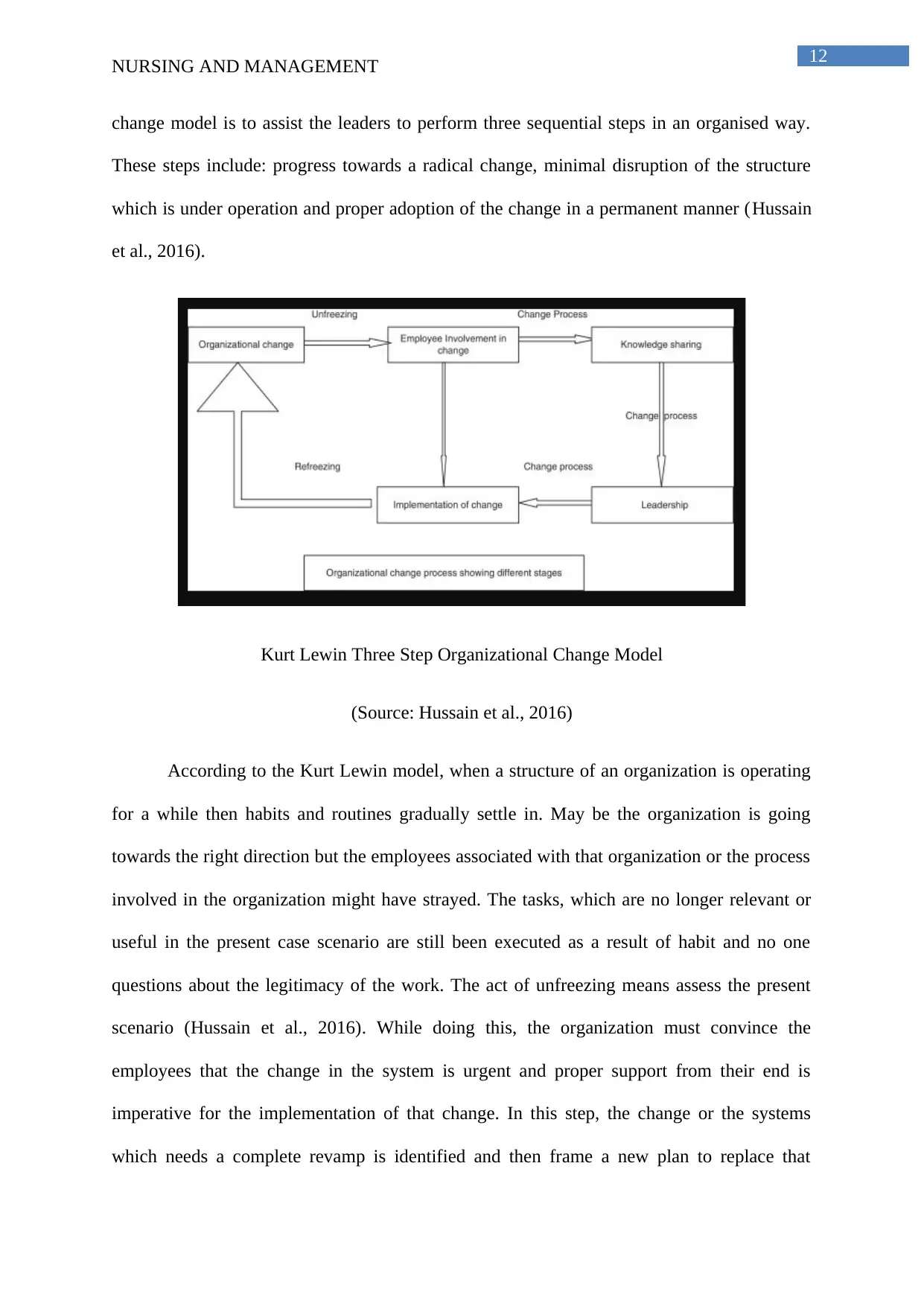
12
NURSING AND MANAGEMENT
change model is to assist the leaders to perform three sequential steps in an organised way.
These steps include: progress towards a radical change, minimal disruption of the structure
which is under operation and proper adoption of the change in a permanent manner (Hussain
et al., 2016).
Kurt Lewin Three Step Organizational Change Model
(Source: Hussain et al., 2016)
According to the Kurt Lewin model, when a structure of an organization is operating
for a while then habits and routines gradually settle in. May be the organization is going
towards the right direction but the employees associated with that organization or the process
involved in the organization might have strayed. The tasks, which are no longer relevant or
useful in the present case scenario are still been executed as a result of habit and no one
questions about the legitimacy of the work. The act of unfreezing means assess the present
scenario (Hussain et al., 2016). While doing this, the organization must convince the
employees that the change in the system is urgent and proper support from their end is
imperative for the implementation of that change. In this step, the change or the systems
which needs a complete revamp is identified and then frame a new plan to replace that
NURSING AND MANAGEMENT
change model is to assist the leaders to perform three sequential steps in an organised way.
These steps include: progress towards a radical change, minimal disruption of the structure
which is under operation and proper adoption of the change in a permanent manner (Hussain
et al., 2016).
Kurt Lewin Three Step Organizational Change Model
(Source: Hussain et al., 2016)
According to the Kurt Lewin model, when a structure of an organization is operating
for a while then habits and routines gradually settle in. May be the organization is going
towards the right direction but the employees associated with that organization or the process
involved in the organization might have strayed. The tasks, which are no longer relevant or
useful in the present case scenario are still been executed as a result of habit and no one
questions about the legitimacy of the work. The act of unfreezing means assess the present
scenario (Hussain et al., 2016). While doing this, the organization must convince the
employees that the change in the system is urgent and proper support from their end is
imperative for the implementation of that change. In this step, the change or the systems
which needs a complete revamp is identified and then frame a new plan to replace that
⊘ This is a preview!⊘
Do you want full access?
Subscribe today to unlock all pages.

Trusted by 1+ million students worldwide
1 out of 23
Related Documents
Your All-in-One AI-Powered Toolkit for Academic Success.
+13062052269
info@desklib.com
Available 24*7 on WhatsApp / Email
![[object Object]](/_next/static/media/star-bottom.7253800d.svg)
Unlock your academic potential
Copyright © 2020–2025 A2Z Services. All Rights Reserved. Developed and managed by ZUCOL.





